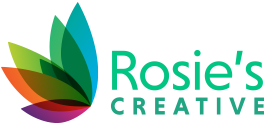
Intro to File Types, Part One: Image Formats for Print Use
 Understanding Digital Media for Print Use
Understanding Digital Media for Print Use
Digital media has transformed marketing for small businesses and local nonprofits – and here at Rosie’s Creative, we’ve had a front-row seat to this seismic shift. With today’s technology, it’s more practical and budget-friendly than ever to build a top-shelf strategy to boost your visibility and engage with target audiences. But, as we all know, with technology often comes a bit of a learning curve.
Working with clients, we get plenty of questions about file types, especially when it comes to digital imaging. So, we thought it would be worth taking some time to review some basic info to help you with managing your digital resources. And since questions about the suitability of various image formats for print projects are high on our “frequently asked” list, we’ll start there.
Before we proceed, it’s key to understand that when we talk about digital imaging, we’re talking about two broad categories of file type – raster images, and vector images.
Raster Images
Raster images are pixel-based and have a set resolution; enlarge a raster image, and you’ll end up with a blurred, “pixelated” final product. Photographs are raster images, so if you’re working with photos, it’s essential that your originals are high-resolution images.
Vector Images
Vector images, on the other hand, are not resolution-dependent; instead, they’re based on curves and lines calculated by your computer. Logos and brand graphics are usually in a vector format, because they can be resized with no loss in fidelity – so, you can put your logo on a business card, or on the side of a truck!
Now, let’s look at a few of the more common image file types you’ll encounter when working with print…
JPG
One of the most widely used image formats, JPG is a “lossy” raster format – meaning it uses technical tricks to slash file size, but at the cost of image quality. High-resolution JPGs (300 dpi) are suitable for proofs, but probably won’t be your first pick for high-quality print collateral.
TIFF
A “lossless” raster format – meaning it retains all data from the original file with no compression – TIFFs are the go-to format for quality print graphics. They’re commonly used in photography and desktop publishing.
AI
A vector format, AI is the proprietary file type developed by Adobe for Illustrator, their industry-standard vector editing software. You can print from this format, but its primary purpose is for saving vector art for further editing.
PDF
Another file type developed by Adobe, PDF has become a nearly ubiquitous format supported by a wide variety of publishing and design programs. Often, when you’re ready to send a final design to print, it will be in PDF format.
EPS
Used mainly as a vector format, though they can also include some raster image data, EPS files are well-suited for high-resolution printing of logos and other vector elements.
Are you looking for practical, results-oriented marketing solutions for your business or nonprofit? Rosie’s Creative is here and ready to help. Contact us today to get started – and remember, with Rosie’s Creative, your first consultation is always free!
